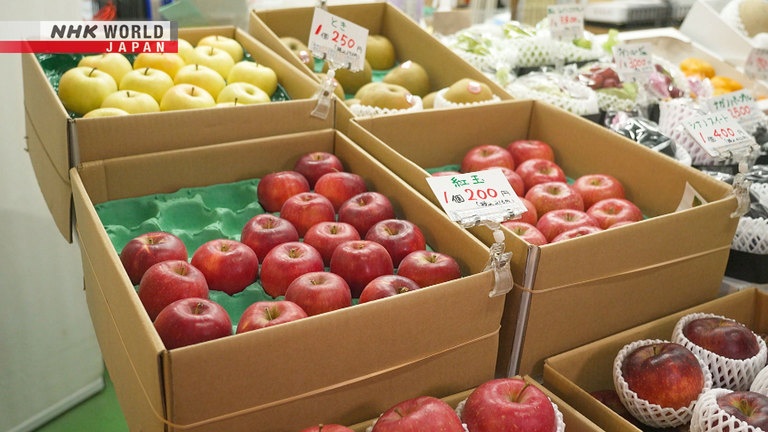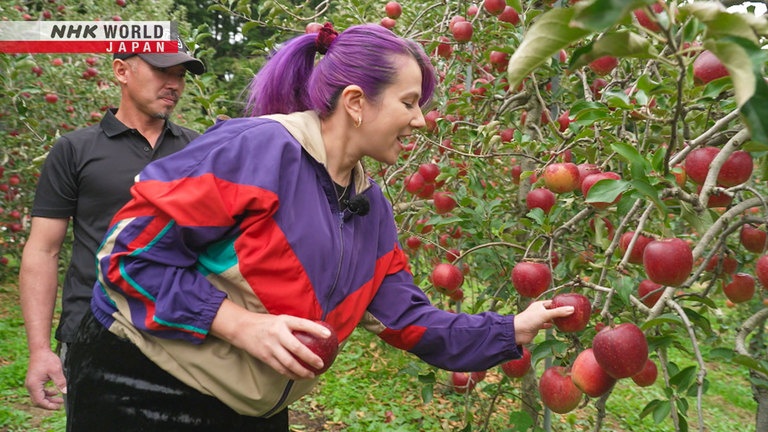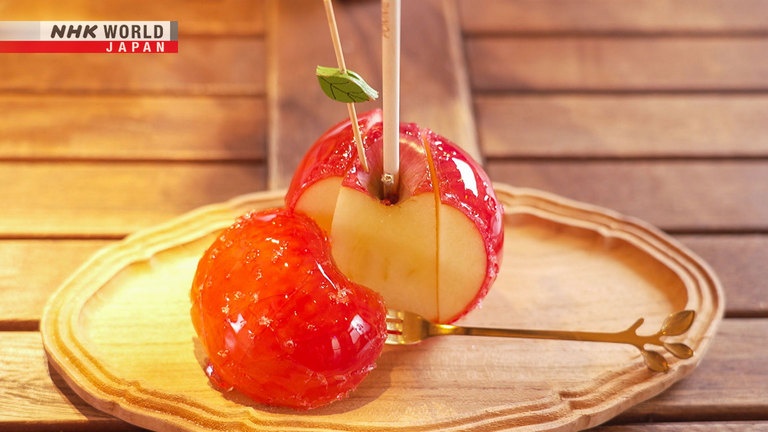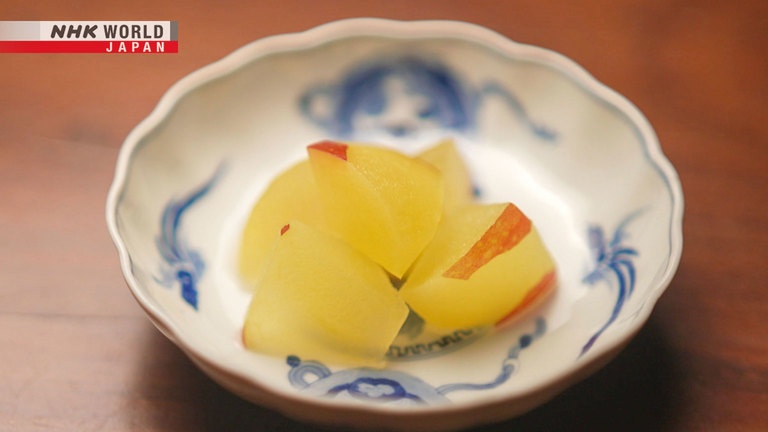APPLES
Nagano Prefecture in central Japan gets long sunlight hours and large temperature drops between day and night. This makes for some tasty apples! Feast your eyes on unique sweets made from native varieties! (Reporter: GOW)




Transcript
Tokyo: this world-class metropolis is a veritable gourmet wonderland.
Discover the stories behind the ingredients that make this city so delicious - so "oishii."
Today, we focus on apples.
It is one of the most popular fruits in the world, with an estimated 15,000 varieties.
Western apples were introduced to Japan from the U.S. about 150 years ago.
Since then, selective breeding has led to a wide variety in Japan.
This is so amazing and delicious.
From innovative sweets
to Japanese cuisine,
apples in Japan continue to evolve in their own unique way.
Let's find out more about Japanese apples, a world-famous fruit.
Trails to Oishii Tokyo.
Hi, everyone. My name is GOW - was born in the UK, have lived in America and the Philippines.
But I have to tell you that when it comes to apples, Japan has the best.
In this episode, we will find out the secret hidden behind those tasty apples.
Come on and follow me!
GOW begins her journey at Tsukiji Outer Market.
It is home to over 400 food sellers, and also a popular tourist destination.
In one corner is Tsukiji Uogashi.
Opened in 2018, the new hub is crowded with food professionals.
GOW visits a produce store with over 100 years of history.
Oh, and here they are! The apples!
As you can see, there are a lot of autumn fruits out here right now.
We got the grapes, we got the persimmons, and of course we got the apple section.
In early October, she finds 5 types of apples.
The prices range from $1.50 to $2.50 a piece, depending on the variety.
There are many kinds of apples.
How can you tell which one is good?
In my opinion, it should be shiny.
The color and shape are also important.
And it should feel heavier than it looks.
Weighty apples mean they contain a lot of juice - making them more delicious!
Where do these apples come from?
The largest producer is Aomori. Then, Nagano.
Nagano has an earlier shipping season
since it's located in the south.
They harvest in October,
producing more and more delicious apples.
Nagano has many original varieties.
One of them is akibae - with a dark ruby-red skin.
It has a nice balance of sweet and sour.
Sort of an old-fashioned flavor.
Meanwhile, shinano sweet is pure sweetness,
and hardly sour.
- So, now is the season for Nagano apples?
- Exactly.
Got it! I will go to Nagano to find more about apples then.
Have a good trip.
GOW heads to Iizuna, about 250 km northwest of Tokyo.
The town is a major apple producer in Nagano.
We're here at the hilltops of the mountain.
It's so fresh. The air is so clear.
So, they have a lot of apples around here, huh?
Hello.
- Nice to meet you.
- I'm here to learn about apples.
Toya Junya is a 4th generation apple farmer.
His family has been in the business for over a century.
Why is Nagano so famous for apples?
One major reason is the clayey soil.
This allows the land to absorb and retain moisture from rain.
There's also a large temperature gap between day and night.
They say the greater the gap, the tastier.
Toya grows 12 types of apples on about 2 hectares of land.
- May I hold them?
- Sure.
- Quite heavy.
- It is.
Heavier than I thought.
Do you want to try picking one?
- Can I?
- Why not?
Which one should I go for?
The akibae variety is deep red, like ruby.
It'd be good to look for darker ones.
I think these have ruby-red colors.
This one's big though.
I'd choose this one.
That? Why?
This one has a rounder shape.
With akibae, you want to look for a sticky feel.
- Really? Sticky?
- Yes.
This one feels rather smooth.
This has a texture, and it feels firm in your hand.
Right. You can tell it's sweet.
So, when I touch it, my thumb sticks to it a little bit, compared to when I touch this one.
And I think that's because - and he said - that it's because of the sweetness that comes out with the juice of the apple.
Oh, it's easier than I thought.
That was quite easy!
I thought I had to twist it...
I thought I'd have to twist it off.
When it's ripe, you don't have to.
It's my first bite of the first apple here at Nagano!
- "Itadakimasu."
- Enjoy.
Oh wow. Very sweet but with a refreshing aftertaste.
Exactly. Akibae has the perfect balance of sweet and sour.
Akibae's harvest season ends in early October, and then it's time for shinano sweet!
These are akibae, and those are shinano sweet.
When this harvest ends, that one starts.
The difference is very visible.
Shinano sweet have a much lighter, pinkish color.
Soon, we start the harvest.
You see that this side is red and ready.
But when you turn it around, it's green.
We rotate it to expose all sides to the sun,
and evenly turn the skin red.
When the entire surface is red, it is ready.
Apples that get more sun exposure look and taste better!
This looks pretty good.
- Very juicy.
- Yes, this one is also filled with juice.
And very sweet.
It doesn't have akibae's sourness,
so the sweetness really stands out.
What a treat to be able to do
a taste-comparison of the two.
- Good for you.
- Lucky me.
Apples make me so happy.
Walking through the apple orchard, GOW notices something.
Being that Newton discovered gravity
by seeing an apple fall from the tree,
I always imagined them to be much taller.
I've never seen a stream of apples like this.
There are many ways of growing apple trees.
This is the new dwarfing cultivation method.
It places them lower and brings more efficiency.
The new dwarfing technique was developed by Nagano's Fruit Tree Research Station.
Trees are planted at close intervals, and branches are pulled by wires for downward growth.
The rows of trees eventually grow into 3-meter walls.
It's very efficient.
We work face-to-face on each row, so nothing is overlooked.
It also gives better ventilation and sun exposure.
This method gives us a lot of benefits.
Does this also improve the taste?
Yeah. Better sunlight contributes to photosynthesis,
making them tastier.
Through apple cultivation, young Iizuna farmers like Toya contribute to the town's development.
In this town, popular by its apples, I've heard that there is a must-go dessert shop around here, but...
Could it be here?
It looks like a school though.
GOW visits a former elementary school, now converted into a complex facility with stores inside.
- Cute café.
- Welcome.
Pastry chef and Iizuna native Ueda Mao started this café.
Her cakes using local fruits are popular.
Here you go. A whole-apple tart.
How impactful!
The baked tart uses a whole shinano piccolo apple.
A whole apple!
Firm texture.
Shinano piccolo have a nice acidity
and crunchiness when eaten raw.
I try to maintain that rawness.
After hollowing out the core and stuffing them with nuts, she bakes them in the oven for 15 minutes.
The baking time differs by apple variety.
Thanks for waiting. Apple tarte tatin. Enjoy.
Looks great.
The apple used here is shinano sweet - three apples per piece!
This is a pure apple delight, with no added sugar or water.
She repeats heating and cooling for 3 days to condense the flavor of the fruit.
It's a one of a kind, with fans traveling from afar just to get a taste.
- "Oishii."
- Thank you.
I think the slight pulpiness is key.
These apples are rather soft
but I try to leave some pulpy texture to it.
In fact, Ueda comes from a family of apple farmers.
Making sweets is her passion.
Despite the time and effort put into producing apples,
there are some misshaped ones.
I buy and use them to make sweets.
They are just as tasty, and you give them purpose.
Right. I add value to them.
She has also started a new project, making juice from each locally-grown apple variety.
She has now reached 30 varieties, aiming for 50.
Where's GOW headed next?
Oh, look at this: Iizuna Apple Museum.
Let's go check out what they have inside.
- Hi.
- Welcome to Apple Museum.
Wow, so many apple-related things.
Yes. In fact, we have about 4,000 apple-related goods here.
All things apple - from dolls, accessories to music can be found here.
Even this apple!
This is the section I'm most excited to introduce.
It's dedicated to kosaka apples,
the town's very own natural treasure.
They were endangered when
western apples came into Japan.
Long before the spread of western apples,
there were Japanese apples primarily grown for ornamental purposes.
Yonezawa Toshiaki saved an Iizuna-grown apple from extinction.
His son, Noriyuki, takes GOW to the tree.
- This is it.
- It really stands out.
I know.
This is a kosaka apple tree after harvest.
What did kosaka apples mean to the town of Iizuna?
Every family used to have a tree or two.
But with tasty western apples coming in,
their popularity faded.
Lamenting the situation,
my father decided to preserve them.
He put a branch in the ground for it to root,
keeping its DNA.
This is called the root division method.
Peel off the bark of a newly sprouted branch, and plant it in the ground.
This allows new seedlings to grow, which inherit the original tree's DNA.
It's been about 30 years since then.
- And this is the tree?
- Yes.
Wow.
These are kosaka apples.
Tiny and cute.
Compared to ordinary western apples, they are very small.
"Itadakimasu."
I'm going to bite into it.
Go ahead.
- Slightly sour.
- Right.
When my father was a kid,
he used to eat them as snacks.
Now, 3 metric tons of these apples are produced each year, often made into cider and juice.
GOW returns to Tokyo.
She visits a shop serving apple sweets which are becoming increasingly popular.
- Welcome.
- Hello.
Thanks for coming.
- Wow, it's so charming!
- Thank you!
What a cute little store!
Let's take a look at the goodies!
Look, I found candy apples!
So many cute ones.
The middle one is a real classic.
Exactly. Plain, the classic.
You enjoy the apple's aroma and flavor
with a simple coat of sweet candy.
Great for first-timers.
Here is the plain one.
It's so cute.
It looks lovely.
At Japanese festivals, you'll find food stalls - where candy apples are an absolute must-have!
I can't even remember when's the last time that I ever ate a candy apple.
I used to love it when I was a kid, but I haven't seen it for a while.
Looks great.
"Itadakimasu."
Very delicious.
The thin coat of candy and the juiciness
of the apple create a perfect harmony.
Thank you.
Wow! Amazing!
Our goal is not just to offer good apples
but to perfect them as candy.
I see.
The candy needs to be tempered very carefully.
Creating a thin coat is a work of art.
The store offers many other flavors.
The cacao flavor is a year-round staple on the menu.
And the cinnamon flavor is blended with two types of sugar.
They also have monthly specials.
For October, enjoy the fine coat of muscat-flavored powder.
Pour some syrup infused with tea olives for a complete experience.
The tea olive aroma spreads in your mouth.
Such an exciting flavor.
Right. The flavor really captures
the excitement of candy apples.
It's very popular.
Candy apples are no longer just a festival treat.
They've transformed into a sweet delicacy enjoyed by adults!
The store's owner travels around the country promoting candy apples.
Hi, Mr. Ikeda. Thank you for your time.
Where are you now?
I'm at the Okinawa branch.
Wow, it's spreading across Japan.
Yeah. I'm working hard.
What got you into candy apples?
In Japan, you could only find them at festival stalls.
I used to think they are Japanese
but I learned that they exist all over the world.
That's when I thought candy apples deserve
to be loved outside of festivals too.
Another thing is the care farmers put into their apples.
They tend to them throughout the year,
nurturing them.
We then take those precious apples,
and serve them in the form of candy apples.
There's a sense of passing on a legacy,
and it's very rewarding.
Candy-coated apples, which are said to have originated in the United States,
continue to evolve in Japan in their own way.
GOW's last stop is a Japanese restaurant in Ginza, Tokyo.
Good evening.
I'm here to try your apple dishes.
Arai Dairin is the owner and chef of this restaurant that mainly serves soba.
He uses apples in his course meals.
Here you go. Pickled apples.
I can tell how fresh they are.
I do my best to preserve the color, texture and aroma.
"Itadakimasu."
The tartness of the lightly picked apples
compliments the natural sweetness of the fruit.
That's exactly what I'm aiming for.
I'm glad you can feel that.
What made you want to use apples?
I'm from Aomori, a major producer of apples.
I wanted to offer a little taste of home in my cooking.
Pickled vegetables are very common there.
I tried doing it with apples, and it worked.
Next up is apples with tofu dressing.
The dressing is made of tofu paste, mixed with sugar and soy sauce.
It's a staple in Japanese cuisine used to dress various ingredients.
First, he fries the apples.
This will bring out the sweetness and flavor,
and makes the apples slightly softer.
This way, you get to enjoy different textures in one dish.
He mixes both fried and pickled apples with the tofu paste.
The tofu dressing is very creamy and mild.
That's right.
The lightly pickled apples were refreshing,
whereas this one is creamy.
It's a fine balance, making you crave both.
What you had now is the fried apple.
I add pickled apples to give some crunchiness.
You get to enjoy two different textures and flavors,
all gently wrapped in the tofu dressing.
Full of flavors, and also healthy. That's awesome.
Yes, thank you.
Apples have all of the elements:
good texture, sweetness, acidity, and aroma.
They can be adapted to all kinds of cooking,
with endless possibilities.
I'm excited to explore more of that.
In this episode, I have found out
that the Japan apples are evolving through time and according to our now-a-day-lives.
They have high potential in creating new cuisines, and I am highly respectful for the love and the passion
that the farmers and the chefs put into this wonderful, magnificent fruit.
In Tokyo, every ingredient has its own story.